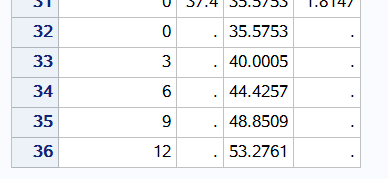SAS学习 day6
回归分析
建模流程:
数据预处理 →数据探索 →模型选择 →残差检验、共线性诊断、强影响点判断 → 模型修正→ 模型预测
残差近似服从正态分布
1、数据探索
- 拟合分布 pp图
- 散点图 研究y和x的线性关系
- 相关系数

拟合分布
认为氧气消耗量为y变量 其余因素作为因变量
proc univariate data = reg.b_fitness; var Runtime -- Performance; histogram Runtime -- Performance / normal; 直方图 统计上看 probplot Runtime -- Performance / normal (mu=est sigma=est color=red w=2); pb图 图形上看 run;
将七个变量的直方图 pb图都画出来 如果不是正态关系 要进行正态的转换
散点图
proc gplot data = reg.b_fitness; plot oxygen_consumption * (runtime age weight run_pulse rest_pulse maximum_pulse performance) /vaxis = axis1 haxis=axis2; symbol v=dot h=2 w=4 color=red; run;

相关系数
proc corr data = reg.b_fitness rank; var runtime age weight run_pulse rest_pulse maximum_pulse performance; with oxygen_consumption; 注意with with后的变量和with前变量的关系 run;

与performance正相关相关系数0.86
有相关关系才有必要建立回归模型
简单线性回归
模型公式: Y = B0 + B1*X + e 其中e服从正态分布 期望值为0
零假设 B1 = 0
备选假设: B1不等于0

1、回归程序
proc reg data= reg.b_fitness; model oxygen_consumption=performance; y变量是等号左边的 oxygen run;
F检验检验整个方程是否有意义

r方表示 可以解释74%的点
T检验检验系数B有没有意义 下图pvalue显示都有意义

2、预测值和置信区间
data need_predictions; input performance @@; datalines; 0 3 6 9 12 ; run;
第一步data步 将数据 0 3 6 9 12保存在need_predictions表中 data predoxy; set reg.b_fitness need_predictions; run;
第二步data步 将原数据集和需要预测的数据集合并 proc reg data = predoxy; model oxygen_consumption = performance / p; p表示预测的意思 id performance; run;

点估计的置信区间
proc reg data = predoxy; model oxygen_consumption = performance / clm cli alpha=.05; id name performance; plot oxygen_consumption*performance / conf pred; symbol1 c =red v=dot; symbol2 c =red; symbol3 c =blue; symbol4 c =blue; symbol5 c =green; symbol6 c =green; run;
clm总体均值的置信区间
cli 观测值的置信区间 alpha 置信度水平

红线 线性方程 蓝线 均值置信区间 绿线 预测值 置信区间



